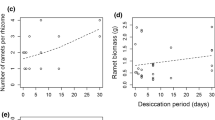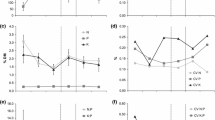Abstract
Background and aims
The ability of modifying biomass allocation to deal with different environmental stress is an important mechanism for plant population expansion and maintenance in the unstable dune environment where wind erosion persists. However, how biomass is partitioned between horizontal rhizome extension and vertical ramet growth in response to wind erosion has not been fully understood. The objective of this study was to explore how wind erosion affected the relationship between horizontal rhizome extension and vertical ramet growth using a common rhizomatous perennial grass, Phragmites communis.
Methods
We dug 300 cm × 200 cm, 80 cm deep pits in a garden experiment plot. Clonal fragments of P. communis were planted individually at a depth of 40 cm in these pits for 4 weeks before treatments. Surface sand was gradually removed to the final depth of 0 (control), 10, 20, 30 and 40 cm (maximum sand removal). Ramet emergence time, rhizome-based and tiller-based ramet number, rhizome number and length, biomass of vertically and horizontally oriented structures were monitored at the end of the experiment.
Results
With increasing erosion depth, the proportion of tiller-based ramets (in total number of ramets) increased, whereas that of rhizome-based ramets decreased. With increasing erosion depth, the percentage of vertically oriented structures biomass in total biomass increased significantly, whereas that of horizontally oriented structures biomass decreased.
Conclusions
The changes in biomass allocation (i.e., more allocation in vertical than horizontal biomass) together with a trade-off in tiller-based and rhizome-based ramets may enable P. communis to make better use of the resources in erosion conditions and maximize plant population expansion and maintenance.





Similar content being viewed by others
References
Aamlid TS (1992) Effects of temperature and photoperiod on growth and development of tillers and rhizomes in Poa pratensis L. Ecotypes 69:289–296
Bai WM, Sun XQ, Wang ZW, Li LH (2009) Nitrogen addition and rhizome severing modify clonal growth and reproductive modes of Leymus Chinensis population. Plant Ecol 205:13–21
Baker JT (2007) Cotton seedling abrasion and recovery from wind blown sand. Agron J 99:556–561
Baker JT, McMichael B, Burke JJ, Gitz DC, Lascano RJ, Ephrath JE (2009) Sand abrasion injury and biomass partitioning in cotton seedlings. Agron J 101:1297–1303
Burylo M, Rey F, Dutoit T (2011) Responses of five woody species to burial by marly sediment: the role of biomass allocation pattern flexibility. J Plant Ecol 27:1–7
Cabaço S, Santos R (2007) Effects of burial and erosion on the seagrass Zostera noltii. J Exp Mar Biol Ecol 340:204–212
Cabaço S, Santos R (2008) The impact of sediment burial and erosion on the seagrasses: A review. Biol Sci 79:354–366
Cao CY, Kou ZW, Jiang DM, Luo YM, Ding XP (2000) Interdune succession in the Kerqin Sandy region. Acta Phytoecologica Sinica 24(3):262–267 (in Chinese with English abstract)
Chen MJ, Jia SX (2002) Forage Floras of China. Agriculture Press, Beijing (in Chinese)
Chen XS, Xie YH, Deng ZM, Li F, Hou ZY (2011) A change from phalanx to guerrilla growth form is an effective strategy to acclimate to sedimentation in a wetland sedge species Carex brevicuspis (Cyperaceae). Flora 206:347–350
Cui SX, Wang W, Zhang CL (2002) Plant regeneration from callus cultures in two ecotyptes of reed (Phragmites communis Trinius). Soc Vitro Biol 38:325–329
Deng ZF, An SQ, Zhao CJ et al (2008) Sediment burial stimulates the growth and propagule production of Spartina alterniflora Loisel. Estuar Coast Shelf Sci 76:818–826
Dong M (1996) Clonal growth in plants in relation to resource heterogeneity: foraging behavior. Acta Bot Sin 38:828–835
Dong M, De Kroon H (1994) Plasticity in morphology and biomass allocation in Cynodon dactylon, a grass species forming stolons and rhizomes. Oikos 70:99–106
Han QY, Bouma TJ, Brun FG, Suykerbuyk W, van Katwijk MM (2012) Resilience of Zostera noltii to burial or erosion disturbances. Mar Ecol Prog Ser 449:133–143
Hara T, Van der Toorn J, Mook JH (1993) Growth dynamics and size structure of shoots of Phragmites Australis, a clonal plant. J Ecol 81:47–60
He YH, Zhao HL, Liu XP, Zhao XY (2009) Growth characteristics of Phragmites australis in typical habitats of Horqin Sandy Land. J Desert Res 29:288–292 (in Chinese with English abstract)
Hermans G, Hammond JP, White PJ, Verbruggen N (2006) How do plants respond to nutrient shortage by biomass allocation? Trends Plant Sci 11:610–617
Hutchings MJ, De Kroon H (1994) Foraging in plants: the role of morphological plasticity in resource acquisition. Adv Ecol Res 25:159–238
Ikegami M, Whigham DF, Werger MJA (2008) Optimal biomass allocation in heterogeneous environments in a clonal plant—Spatial division of labor. Ecol Model 213:156–164
Ivany JA (1997) Effects of rhizome depth in soil on emergence and growth of field mint (Mentha arvensis). Weed Technol 11:149–151
Iwasa Y, Roughgarden J (1984) Shoot-root balance of plants: optimal growth of a system with many vegetative organs. Theor Popul Biol 25:78–105
Jiang DM, Wang HM, Li XH, Lou YM, Li XL (2005) Analysis on the change trend of air temperature in the Ulan’ aodu region in the Horqin Sandland. Arid Zone Res 22:322–325 (in Chinese with English abstract)
Klimeš L (2000) Phragmites australis at an extreme altitude: rhizome architecture and its modelling. Folia Geobotanica 35:403–417
Landhāusser SM, Stadt KJ, Lieffers VJ, McNabb DH (1996) Rhizome growth of Calamagrostis Canadensis in response to soil nutrients and bulk density. Can J Plant Sci 76:545–550
Levin N, Kidron GJ, Ben-dor E (2008) A field quantification of coastal dune perennial plants as indicators of surface stability, erosion or deposition. Sedimentology 55:751–772
Li SL, Werger MJA, Zuidema PA, Yu FH, Dong M (2010a) Seedlings of the semi-shrub Artemisia ordosica are resistant to moderate wind denudation and sand burial in Mu Us sandland, China. Trees-Struct Funct 24:515–521
Li SL, Zuidema PA, Yu FH, Werger MJA, Dong M (2010b) Effects of denudation and burial on growth and reproduction of Artemisia ordosica in Mu Us Sandland. Ecol Res 25:655–661
Liu B, Liu ZM, Wang LX (2012) The colonization of active sand dunes by rhizomatous plants through vegetative propagation and its role in vegetation restoration. Ecol Eng 44:344–347
Macdonald SE, Lieffers VJ (1993) Rhizome plasticity and clonal foraging of Calamagrostis Canadensis in response to habitat heterogeneity. J Ecol 81:769–776
Marbà N, Duarte CM (1998) Rhizome elongation and seagrass clonal growth. Mar Ecol Prog Ser 174:269–280
Michels K, Armbrust DV, Allison BE, Sivakumar MVK (1995) Wind and windblown sand damage to Pearl millet. Agron J 87:620–626
Mook JH, Van der Toorn J (1982) The influence of environmental factors and management on stands of Phragmites australis.II. Effects on yield and its relationships with shoot density. J App Ecol 19:501–517
Muller I, Schmid B, Weiner J (2000) The effect of nutrient availability on biomass allocation patterns in 27 species of herbaceous plants. Perspect Plant Ecol 3:115–127
Nus JL, Hodges CF (1990) Tiller and rhizome growth of water-stressed Poa pratensis ‘Merion’ Infented by Ustilago striiformis or Urocystis agropyri. Plant Dis 74:886–888
Pavlik BM (1983) Nutrient and productivity relations of the dune grasses Ammophila areanaria and Elymus molli. III. Spatial aspects of clonal expansion with reference to rhizome growth and the didpersal of buds. Bull Torrey Bot Club 110:271–279
Powelson RA, Lieffers VJ (1992) Effects of light and nutrients on biomass allocation in Calamagrostis canadensis. Ecography 15:31–36
Song YB, Yu FH, Li JM, Keser LH, Fischer M, Dong M, van Kleunen M (2013) Plant invasiveness is not linked to the capacity of regeneration from small fragments: an experimental test with 39 stoloniferous species. Biol Invasions 15:1367–1376
Stuefer JF, De Kroon H, During HJ (1996) Exploitation of environmental heterogeneity by spatial division of labour in a clonal plant. Funct Ecol 10:328–334
Van der Toorn J, Mook JH (1982) The influence of environmental factors and management on stands of Phragmites australis. I. Effects of burning, frost and insect damage on shoot density and shoot size. J App Ecol 19:477–499
Waisel Y, Rechaw Y (1971) Ecotypic differentiation in Phragmites communis Trin. Hydrobiologia 12:259–266
Wang HL, Zhang CL (1995) Seasonal changes of endogenous ABA and cytokinins in environmental adaptation of different ecotypes of reed plants. J Environ Sci 7:449–454
Wang LX, Mou PP, Jones RH (2006) Nutrient foraging via physiological and morphological plasticity in three plant species. Can J Forest Res 36:164–173
Wang ZW, Xu AK, Zhu TC (2008) Plasticity in bud demography of a rhizomatous clonal plant Leymus chinensis L. in response to soil water status. J Plant Biol 51:102–107
Wang JF, Gao S, Lin JX, Mu YG (2010) Summer warming effects on biomass production and clonal growth of Leymus chinensis. Crop Pasture Sci 61:670–676
Watson MA, Casper BB (1984) Morphogenetic constraints on patterns of carbon distribution in plants. Ann Rev Ecol Syst 15:233–258
Weigelt A, Steinlein T, Beyschlag W (2005) Competition among three dune species: the impact of water availability on below-ground process. Plant Ecol 176:57–68
Weiner J (2004) Allocation, plasticity and allometry in plants. Perspect Plant Ecol 6:207–215
Wildová R (2004) Below-ground spatial pattern of rhizomes in a grassland community and its relevance to above-ground spatial pattern. Plant Ecol 174:319–336
Wolfer SR, van Nes EH, Straile D (2006) Modelling the clonal growth of the rhizomatous macrophyte Potamogeton perfoliatus. Ecol Model 192:67–82
Xu ZZ, Huang LM, Huang XP, Zhu AJ, Zhang S (2009) Growth strategy of seagrass Thalassia hemprichii in Xincun Bay near Hainan island of China. Mar Sci Bull 11:53–61
Xu L, Yu FH, Werger M, Dong M, Anten APR (2013) Interactive effects of mechanical stress, sand burial and defoliation on growth and mechanical properties in Cyanchum komarovii. Plant Biol 15:126–134
Yan SG (2011) Vegetation processes of transition zones between active dunes and interdune lowlands in semi-arid dune areas. PhD Thesis, Beijing, Chinese Academy of Sciences
Yan SG, Liu ZM (2010) Effects of dune stabilization on the plant diversity of interdune wetlands in northeastern Inner Mongolia, China. Land Degrada Dev 21:40–47
Yan QL, Liu ZM, Ma JL, Jiang DM (2007) The role of reproductive phenology, seedling emergence and establishment of perennial Salix gordejevii in active sand dune fields. Ann Bot 99:19–28
Yu FH, Wang N, He WM, Chu Y, Dong M (2008) Adaptation of rhizome connections in drylands: increasing tolerance of clones to wind erosion. Ann Bot 102:571–577
Zhang JT, Mu CS, Wang DL, Wang JF, Chen GX (2009) Shoot population recruitment from a bud bank, over two seasons of undisturbed growth of Leymus chinensis. Can J Bot 87:1242–1249
Zhao LQ, Cui SX, Zhang LX, Zhang CL (2004) The survival mechanism of dune reed (Phragmites communis) cultures under high sodium chloride concentration. Plant Cell Tiss Org 79:291–298
Acknowledgments
We thank Xiumei Wang, Hongmei Wang, Yongming Luo, Jianjiang Qian, Jinlei Zhu, Feilong Hu and Chuanfu Zang for field and laboratory assistance. We also thank section editor Dr. Walck and two anonymous reviewers for their helpful comments and suggestions that improved this manuscript greatly. The study was financially supported by National Natural Science Foundation of China (No. 31200539) and Key Project of Chinese National Programs for Fundamental Research and Development (No. 2013CB429903). Lixin Wang acknowledges the financial support from iM2CS-GEIRE of IUPUI.
Author information
Authors and Affiliations
Corresponding author
Additional information
Responsible Editor: Jeffrey Walck.
Rights and permissions
About this article
Cite this article
Liu, B., Liu, Z., Wang, L. et al. Responses of rhizomatous grass Phragmites communis to wind erosion: effects on biomass allocation. Plant Soil 380, 389–398 (2014). https://doi.org/10.1007/s11104-014-2104-y
Received:
Accepted:
Published:
Issue Date:
DOI: https://doi.org/10.1007/s11104-014-2104-y




